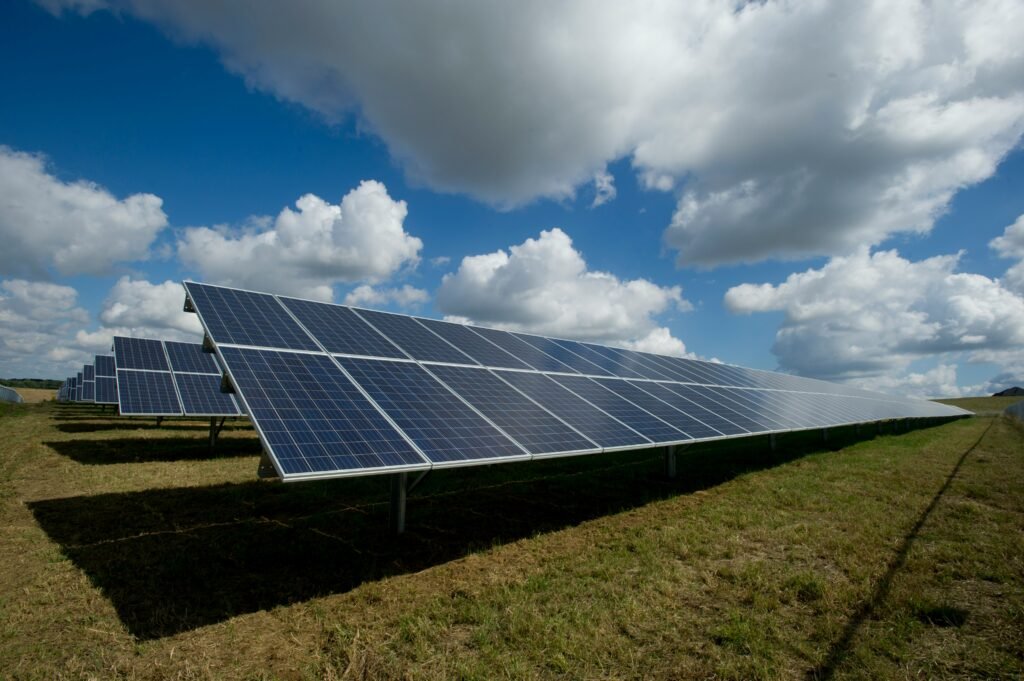
What is a Solar Panel?
A solar panel is a device that converts sunlight into electricity, making it a crucial component of sustainable energy systems. The primary purpose of solar panels is to harness the sun’s renewable energy, which can be utilized in various applications, including residential, commercial, and industrial settings. Understanding the function and components of solar panels is essential to appreciate their role in promoting energy efficiency and reducing carbon footprints.
At the core of every solar panel are photovoltaic (PV) cells, which are responsible for the conversion process. These cells are made from semiconductor materials, such as silicon, which absorb sunlight and generate an electric current through the photovoltaic effect. When sunlight strikes the PV cells, it excites electrons within the material, creating an electric flow. This direct current (DC) electricity is then converted into alternating current (AC) electricity through an inverter, making it usable for household appliances or feeding it back into the electric grid.
Solar panels can be deployed in various settings to capture solar energy effectively. In residential areas, they are typically mounted on rooftops, allowing homeowners to generate their electricity while reducing reliance on fossil fuels. In commercial applications, large solar arrays may be installed on buildings or solar farms, enabling businesses to substantially lower energy costs and contribute to sustainable practices. Industrial settings can leverage solar technology to power operations, further emphasizing the multifaceted use of solar panels in reducing environmental impact.
As the demand for clean energy continues to rise, understanding solar panels and their capabilities is vital for anyone interested in sustainable development. Their role in generating renewable energy not only supports the reduction of greenhouse gas emissions but also plays a key role in the global shift towards more sustainable energy solutions.
The Importance of Solar Energy
In contemporary society, solar energy has emerged as a fundamental component in the quest for sustainable energy solutions. This renewable resource plays a pivotal role in mitigating the adverse effects of climate change. By harnessing sunlight, solar power significantly reduces greenhouse gas emissions, which are primarily responsible for global warming. As opposed to traditional fossil fuels, solar energy generates electricity without emitting carbon dioxide, thus contributing to a cleaner and healthier environment.
Furthermore, the adoption of solar energy reduces dependence on fossil fuels, which are limited and contribute to environmental degradation through extraction and burning processes. The shift to a solar-based energy system can foster energy independence for both households and businesses. By investing in solar panels, property owners can generate their own electricity, reduce their energy costs, and ultimately contribute to a more stable and secure energy grid. This independence is particularly crucial in a world where fluctuations in fossil fuel prices can have a significant impact on economic stability.
Solar energy not only benefits the environment but also offers economic advantages. The growing solar industry creates jobs in the manufacturing, installation, and maintenance of solar technologies. Additionally, as technology advances, the cost of solar panels continues to decline, making them more accessible to a broader audience. This affordability drives higher adoption rates, further accelerating the transition to renewable energy sources.
In essence, embracing solar energy represents a vital step toward a sustainable future. As governments and individuals recognize the importance of renewable resources, solar power stands out as a reliable and practical choice, capable of meeting the energy needs of an increasingly energy-conscious society.
Innovative Features of the New Solar Panel
The latest solar panel technotelogy has garnered significant attention due to its groundbreaking features that distinguish it from previous models. These innovations not only enhance efficiency but also improve design, durability, and installation methods. One of the most notable advancements in the new solar panels is their increased energy conversion efficiency. Utilizing advanced photovoltaic materials, these panels achieve higher energy output even under less-than-ideal sunlight conditions. This means homeowners and businesses can generate more electricity for their needs, leading to greater sustainability and reduced reliance on traditional energy sources.
In addition to efficiency, the design of these solar panels has evolved to be more aesthetically pleasing and versatile. The new models are slimmer and can be integrated seamlessly into rooftops or other structures, allowing for a more harmonious appearance with the surrounding architecture. This improvement encourages more property owners to consider solar technology, as the visual impact is often a concern. Furthermore, the innovative designs may also include bifacial panels, which capture sunlight from both sides, further maximizing solar energy production.
Durability is another key feature of the latest solar panels. Constructed with weather-resistant materials and enhanced protective coatings, these panels are designed to withstand harsh environmental conditions, including hail, heavy rain, and extreme temperatures. This longevity not only ensures sustained performance but also reduces the need for frequent replacements, thus lowering long-term costs for users.
Lastly, the installation methods for these new solar panels have been refined. With user-friendly mounting systems and lighter materials, installations are quicker and require fewer specialized skills. Homeowners can often benefit from reduced labor costs, making the transition to solar energy more accessible than ever. In conclusion, the innovative features of the new solar panels mark a significant step forward in the quest for sustainable energy solutions, providing enhanced performance and usability for a diverse range of applications.
Understanding the Functionality of the New Solar Panel
The new solar panel represents a significant advancement in photovoltaic technology, primarily focusing on optimizing the photovoltaic (PV) effect. At its core, the photovoltaic effect is the process by which solar energy is converted into electrical energy. When sunlight hits the solar cells, photons from the sunlight excite electrons within the material, typically silicon, creating a flow of electricity. The innovative design of the latest solar panel involves the incorporation of advanced materials and engineering techniques to enhance this fundamental process.
One of the key improvements in the new solar panel is the use of tandem cell technology, which combines different types of solar cells into a single unit. This configuration allows for a broader spectrum of light absorption, resulting in higher energy conversion rates. Traditional solar panels generally have a maximum efficiency of around 20%, while the latest innovation can achieve efficiencies exceeding 30%. This increase is vital for maximizing energy output, particularly in space-constrained environments, making these panels more effective and economically viable.
In addition to improved efficiency, the new solar panels employ state-of-the-art energy storage systems that utilize lithium-ion batteries. These systems allow for solar energy to be stored for later use, mitigating the inconsistencies inherent in solar power generation due to variable sunlight conditions. Furthermore, the integration with the electrical grid has been simplified, enabling seamless energy transfer and distribution. This allows users to not only rely on solar energy during peak production times but also to contribute excess energy back to the grid, promoting sustainability and energy independence.
Overall, the technological advancements present in the new solar panel signify a major leap towards more efficient, sustainable energy solutions. With improved photovoltaic processes and enhanced energy management, these solar panels are not only paving the way for greener energy but also demonstrating practical usability in everyday applications.
Comparative Analysis: New Solar Panel vs. Older Models
The advent of new solar panel technology has significantly transformed the landscape of sustainable energy production. When contrasting the latest solar panels with older models, several key factors come into focus, including efficiency, cost, maintenance, and longevity.
One of the most prominent advancements in the new solar panels is efficiency. Modern variants typically boast efficiency ratings exceeding 22%, while older models often falter in the range of 15-18%. This improvement means that newer solar panels can convert more sunlight into usable energy, allowing for better performance even in less than ideal weather conditions. Consequently, homeowners and businesses can expect higher energy outputs from smaller installations, thereby maximizing space utility.
Cost considerations also play a crucial role in this comparison. Initially, new solar panels may appear to have higher price points. However, the long-term savings due to increased efficiency and reduced energy bills often outweigh the initial investment. Additionally, many countries offer incentives or rebates for installing advanced solar technology, making them more accessible for consumers. In contrast, older models may seem cheaper upfront but often lead to larger financial burdens in the long run due to lower energy generation and potential maintenance costs.
Maintenance is yet another critical factor. Newer solar panels are designed with durability in mind, often featuring better resistance against environmental factors. As a result, they generally require less frequent servicing and carry longer warranties, which can range up to 25 years or more. Comparatively, older panels may necessitate more ongoing maintenance to sustain efficiency levels, involving additional costs and inconvenience for the user.
In terms of longevity, the latest solar technology is engineered to last longer, benefiting from advances in material science and manufacturing processes. While older solar panels may exhibit diminishing returns over time, newer models tend to maintain higher efficiency levels throughout their lifespan. This overall reliability adds to their appeal for potential users looking to invest in renewable energy solutions.
Installation Process of the New Solar Panel
The installation process for the new solar panel is a meticulous procedure that requires careful planning and execution to ensure optimal performance. Before commencing the installation, it is essential to evaluate site prerequisites. This includes assessing the roof’s angle, direction, and shading, alongside measuring the space available for solar panel placement. These factors are crucial for maximizing energy capture from sunlight, thereby enhancing the efficiency of the solar energy system.
Once these prerequisites are met, the installation can proceed in several key steps. First, securing proper permits is vital, as local regulations often mandate specific codes for solar panel installations. After obtaining these permits, next is the mounting of the solar panel brackets. This typically involves marking the planned locations on the roof, drilling pilot holes, and using anchors to ensure a secure fit. Once the brackets are installed, the solar panels are carefully placed onto the mounted structures, ensuring they are securely fastened and properly aligned.
Following the panel installation, a connection to the inverter is necessary. The inverter is responsible for converting the direct current (DC) generated by the solar panels into alternating current (AC), suitable for household use. After wiring the solar panels to the inverter, the final step involves connecting the inverter to the home’s electrical system. At this phase, it is prudent to enlist the aid of licensed electricians or professional solar installation services to ensure safety and compliance with electrical codes.
For those discerning DIY enthusiasts, the installation can be attempted independently; however, it is critical to possess a thorough understanding of solar technology and electrical systems. Careful consideration of local laws, safety measures, and equipment requirements must be taken into account to mitigate risks. Seeking guidance from instructional resources or consulting professionals can be beneficial in ensuring a successful installation of the new solar panels.
Cost and Financing Options
The introduction of the latest solar panels presents a significant opportunity for consumers seeking sustainable energy solutions. However, understanding the financial implications is vital for informed decision-making. The initial investment in solar panels can be substantial; however, the long-term savings on energy bills may offset these costs. With rising electricity rates, many homeowners find that installing solar panels leads to considerable reductions in their monthly energy expenditures. Over time, the cumulative savings can make solar a financially sound choice.
In terms of cost, the latest innovation in solar technology may be slightly more expensive than previous models due to advanced materials and improved efficiency. Nevertheless, the efficiency of these panels allows for increased energy production, which can accelerate the return on investment. Several studies indicate that homes equipped with modern solar panels can pay off their initial costs within a span of 5 to 10 years, after which the generated energy is essentially free.
Financing options play a crucial role in making solar energy accessible to a wider audience. Consumers have multiple avenues available to them, including solar loans, leases, and power purchase agreements (PPAs). Solar loans allow homeowners to finance the purchase upfront, while leases provide an opportunity for consumers to pay a monthly fee for using the solar panels without the requirement of owning them outright. The PPA option allows individuals to pay only for the energy produced, further reducing upfront costs. Additionally, many governments offer incentives, grants, and tax credits aimed at lowering installation expenses and encouraging the shift towards renewable energy sources.
Engaging with a financial advisor knowledgeable about solar energy can help consumers navigate these financing options effectively. By leveraging available financial programs, homeowners can facilitate a smoother transition to solar energy and take steps towards sustainable living.
Real-Life Case Studies and User Experiences
The integration of the latest solar panel technology has garnered attention from various sectors, showcasing a broad spectrum of user experiences. Both residential and commercial adopters have reported substantial benefits, emphasizing the effectiveness of this innovation in sustainable energy solutions.
One notable case study involves a family in California who installed the new solar panels on their rooftop. Prior to the installation, their monthly electricity bill averaged approximately $200. Following the upgrade, they report a dramatic decrease in costs, ultimately achieving net-zero energy consumption. This family expressed particular satisfaction with the reduction in their carbon footprint, stating, “Not only are we saving money, but we are also contributing positively towards environmental sustainability.”
In a commercial setting, a small business owner in Texas decided to invest in solar panels to mitigate rising energy costs. The initial investment for the solar technology was significant; however, the business saw a return on investment in just under three years due to reduced utility expenses and government incentives. The owner commented on the experience, “Switching to solar was one of the best decisions for my business, allowing me to allocate funds more effectively while improving my brand image as an eco-friendly enterprise.”
Moreover, testimonials from users indicate an overall increase in satisfaction with their energy systems. Many have highlighted that the panels have proven to be highly efficient even under varying weather conditions, surpassing initial performance expectations. Additionally, users report a decrease in maintenance concerns, reinforcing the reliability of modern solar technologies. This feedback paints a compelling picture of the advantages offered by the latest solar panel innovations, ranging from financial savings to environmental impact.
Future of Solar Technology
The advancement of solar technology holds immense promise for both energy efficiency and accessibility in the coming years. As the global demand for cleaner energy solutions intensifies due to climate concerns and economic factors, researchers and innovators are continually exploring avenues that enhance the efficiency and affordability of solar panels. One key area of research is the development of advanced materials. Researchers are investigating perovskite solar cells, which have shown potential for higher efficiency rates compared to traditional silicon-based options. These innovative materials could significantly reduce production costs, making solar energy more accessible to a broader demographic.
Additionally, the trend toward integrating solar technology with other renewable energy systems presents an exciting frontier. Hybrid systems that combine solar energy with wind or hydroelectric power could enhance energy reliability while utilizing existing infrastructures. This integration may emerge as a standard method for harnessing renewable energy, offering consumers an efficient and viable energy solution. Moreover, advancements in energy storage technologies, particularly lithium-ion batteries and beyond, are paramount for residential applications. Improved battery technology would enable homeowners to store excess energy generated during peak sunlight hours, thus increasing energy independence and reducing reliance on the grid.
The future of solar technology may also see innovations in smart grids and the Internet of Things (IoT). The implementation of smart grids will allow for better energy distribution and real-time energy management, making solar installations even more effective for consumers. Furthermore, integrating IoT devices with solar systems can revolutionize how energy consumption is monitored and optimized in residential and commercial settings.
As governments and organizations worldwide continue to support the research and development of solar energy, the potential for novel technology seems limitless. This innovative mindset promises an era where solar energy is not only ubiquitous but also an affordable and efficient solution for consumers globally.

